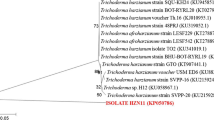Abstract
Coffee cherry husk (CH) is one of the major by-products obtained from coffee processing industry and accounts to 43 ± 5.9 % of cellulose. Screening of fungal organism for cellulase production was carried out and the potential organism was identified as Rhizopus stolonifer by internal transcribed spacer’s (ITS)—5.8S rDNA analysis. A systematic study with response surface methodology (RSM) based on CCRD was used to study the interactions among the variables such as pH (3–7), moisture (40–80 %) and progression duration (72–168 h) of the fermentation process to maximize the enzyme production. Under the optimized cultivation condition, R. stolonifer synthesized 22,109 U/gds. Model validations at optimum operating conditions showed excellent agreement between the experimental results and the predicted responses with a confidence level of 95 %. Endoglucanase thus produced was utilized for ethanol production by simultaneous saccharification and fermentation and maximum of 65.5 g/L of ethanol was obtained. This fungal cellulase has also reported to be efficient detergent additives and promising for commercial use. The present study demonstrates coffee husk as a significant bioprocess substrate. Statistical optimization with major parameters for cellulase production can be highly applicable for industrial scale. Furthermore, value addition to coffee husk with sustainable waste management leading to environment conservation can be achieved.




Similar content being viewed by others
References
Murthy PS, Manonmani HK (2008) Bioconversion of coffee industry wastes with white rot fungi Pleurotus florida. Res J Env Sci 2:145–150
Krishna C (2005) Solid state fermentation systems: an overview. Crit Rev Biotechnol 25:1–30
Bhat MK, Bhat S (1997) Cellulose degrading enzymes and their potential industrial applications. Biotechnol Adv 15:583–620
Bhat MK (2000) Cellulases and related enzymes in biotechnology. Biotechnol Adv 18:355–383
Anbu P, Gopinath SCB, Hilda A, Lakshmipriya T, Annadurai G (2007) Optimization of extracellular keratinase production by poultry farm isolates Scopulariopsis brevicaulis. Bioresour Technol 98:1298–1303
Barnett HL, Hunter BB (1998) Illustrated genera of imperfect fungi. APS Press, St. Paul
Vu VH, Pham TA, Kim K (2009) Fungal strain improvement for cellulase production using repeated and sequential mutagenesis. Mycobiol 37:267–271
Tamura K (1992) Estimation of the number of nucleotide substitutions when there are strong transition-transversion and G + C-content biases. Mol Biol Evol 9:678–687
Tamura K, Peterson D, Peterson N, Stecher G, Nei M, Kumar S (2011) MEGA5: molecular evolutionary genetics analysis using maximum likelihood, evolutionary distance, and maximum parsimony methods. Mol Biol Evol 28:2731–2739
Mandels M, Weber J (1969) The production of cellulase. Adv Chem Series 95:391–414
Mandels M, Andreotti R, Roche C (1976) Measurement of saccharifying cellulose. Biotechnol Bioeng Symp 6:21–33
Miller GL (1959) Use of dinitrosalicylic acid reagent for determination of reducing sugar. Anal Chem 31:426–428
Haaland PD (1990) Experimental design in biotechnology. Elsevier Science Publishing Co., New York
Seo HB, Kim HJ, Jung HK (2009) Measurement of ethanol concentration using solvent extraction and dichromate oxidation and its application to bio-ethanol production process. J Ind Microbiol Biotechnol 36:285–292
Shahriarinour M, Wahab MNA, Ariff AB, Rosfarizan M (2011) Screening, isolation and selection of cellulolytic fungi from oil palm empty fruit bunch fiber. Biotechnol 10:108–113
Joshi A, Pund S, Nivsarkar M, Vasu K, Shishoo C (2008) Dissolution test for site-specific release isoniazid pellets in USP apparatus 3 (reciprocating cylinder): optimization using response surface methodology. Eur J Pharm Biopharm 69:769–775
Mrudula S, Murugammal R (2011) Production of cellulase by Aspergillus niger under submerged and solid state fermentation using coir waste as a substrate. Braz J Microbiol 42:1119–1127
Sun H, Ge X, Hao Z, Peng M (2010) Cellulase production by Trichoderma sp. on apple pomace under solid state fermentation. Afr J Biotechnol 9:163–166
Rajeev K, Sukumaran RK, Singhania RR, Mathew GM, Pandey A (2009) Cellulase production using biomass feed stock and its application in lignocellulose saccharification for bio-ethanol production. Renew Energy 34:421–424
Pericin MD, Madarev ZS, Radulovic MLj, Škrinjar MM (2008) Evaluate of pumpkin oil cake as substrate for the cellulase production by Penicillium roqueforti in solid state fermentation. Roum Biotech Lett 13:3815–3820
Das A, Bhattacharya S, Roopa KS, Yashoda SS (2011) Microbial utilization of agronomic wastes for cellulase production by Aspergillus niger and Trichoderma viride using solid state fermentation. Dyn Biochem Process Biotech Mol Biol 5:18–22
Bondkly AM, Gendy MM (2012) Cellulase production from agricultural residues by recombinant fusant strain of a fungal endophyte of the marine sponge Latrunculia corticata for production of ethanol. Antonie Van Leeuwenhoek 101:331–346
Aro N, Saloheimo A, Ilmen M, Penttila M (2001) ACEII, a novel transcriptional activator involved in regulation of cellulase and xylanase genes of Trichoderma reesei. J Biol Chem 276:24309–24314
Tang YQ, Koike Y, Liu K, An MZ, Morimura S, Wu XL, Kida K (2008) Ethanol production from kitchen waste using the flocculating yeast Saccharomyces cerevisiae strain KF-7. Biomass Bioenergy 32:1037–1045
Acknowledgments
The authors are thankful to the Director, Central Food Technological Research Institute, Mysore and Head, Plantation products, Spices and Flavor Technology Department for providing the facilities and support to carry out this study. The authors also wish to acknowledge the Council of Scientific and Industrial Research, New Delhi for funding this project.
Author information
Authors and Affiliations
Corresponding author
Rights and permissions
About this article
Cite this article
Navya, P.N., Pushpa, S.M. Production, statistical optimization and application of endoglucanase from Rhizopus stolonifer utilizing coffee husk. Bioprocess Biosyst Eng 36, 1115–1123 (2013). https://doi.org/10.1007/s00449-012-0865-3
Received:
Accepted:
Published:
Issue Date:
DOI: https://doi.org/10.1007/s00449-012-0865-3




